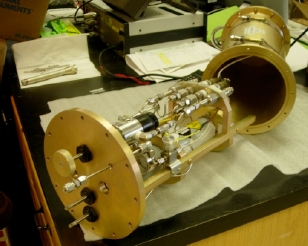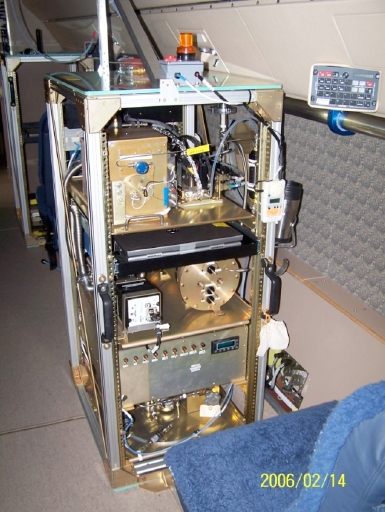

Principal Investigator: Teresa Campos
Co-Investigators: Ilana Pollack, Andrew Weinheimer
Organization:
National Center for Atmospheric Research
Atmospheric Chemistry Division
3450 Mitchell Lane
Boulder, CO 80301
Phone: (303)-497-1048 (Teresa Campos)
E-mail: campos@ucar.edu, ipollack@ucar.edu, wein@ucar.edu
Research Group: Community Airborne Research Instrumentation (CARI)
The operating principle of the O3 instrument is the measurement of chemiluminescence from the reaction of nitric oxide (NO) with ambient O3 using a dry-ice cooled, red-sensitive photomultiplier employing photon counting electronics.
Reaction Vessel Chemistry:
O3 + NO → NO2* + O2
→ NO2 + O2
NO2* → NO2 + hv (600 nm < l < 2800 nm)
NO2* + Mi → NO2 + Mi

The reagent NO (grade >99%) is supplied from a commercially purchased lecture bottle filled to a maximum pressure of 500 psig. Since NO is a toxic gas, the small high pressure cylinder, its regulator, and several safety features are contained inside a specially designed pressure safe vessel that is vented overboard the aircraft.
Ambient air is sampled through a standard HIMIL inlet protruding outside the aircraft boundary layer. Ambient air sample flow is controlled to 500 sccm, while the NO reagent is introduced to the reaction vessel in near-excess flow of ~ 4 sccm. Gas flows as well as the reaction vessel temperature (35 ± 0.1°C) and pressure (10 ± 0.05 torr) are all controlled at constant conditions resulting in maximum stability of the detected signal and instrument sensitivity.
The instrument sensitivity (~2000 cps/ppbv) is determined from calibrations performed on the ground before and after each flight or set of back-to-back flights using a UV absorption based calibrator (TECO model 49PS) operated with high-quality ultra-pure air. A near-linear calibration curve is generated in 100 ppb intervals from 0 to 1 ppm. This calibration range is sufficient to measure O3 mixing ratios over the altitude range of the aircraft.

The fast-O3 instrument has been specifically developed for use onboard HIAPER, the NSF/NCAR G-V aircraft. The instrument requires several accessories in addition to the instrument module to operate effectively. Therefore, the total Fast-O3 equipment rack consists of several major components. The fast-O3 instrument module (~25 lbs) houses the reaction vessel and PMT. A small scroll pump (~30 lbs) allows operation of the instrument’s reaction vessel at the desired pressure and flow rate. A nitric oxide containment vessel (26 lbs) supplies the reagent NO to the reaction vessel in the instrument. The DAQ (~45 lbs) which acts as a power supply unit as well as data recording system for the chemiluminescence signal as well as several instrument housekeeping signals. A KVM or laptop installed in the equipment rack allows interface with LabView based software in the DAQ.
A 0-10 VDC signal corresponding to a preliminary O3 mixing ratio (0-1 ppm range) can be output to the aircraft data system upon request.
Sensitivity: ~2000 cps/ppbv
Background: ~100 cps
Detection Limit: 0.02 ppbv
Time Response: 1 Hz (Instrument can have 5 Hz capability, depending on inlet configuration.)
Linear Range: 1 ppbv → 1000 ppbv (O3)
Ridley, B. A., and F. E. Grahek, A small, low flow, high sensitivity reaction vessel for NO chemilum-inescence detectors, J. Atmos. Oceanic Technol., 7, 307-311, 1990.
Ridley, B. A., F. E. Grahek, and J. G. Walega, A small, high-sensitivity, medium-response ozone detector for measurements from light aircraft, J. Atmos. Oceanic Technol., 9, 142-148, 1992.